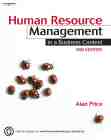 Introduction
Introduction
This section considers how opportunities are constrained to the detriment of individuals
and organizations. We examine how businesses and their managers can maximise human capital.
 The environment and opportunity
The environment and opportunity
Anthony Jay is reputed to have said that 'success is when preparation meets opportunity'. Preparation depends on personal effort
but opportunity is linked to social factors such as economic conditions, education and other people. Effectively, society determines who is given opportunity and who is not through the process of discrimination. Overt prejudice is comparatively
easy to observe but the true nature of unfairness lies in the way opportunity has been institutionalized within society. The status quo is constructed to benefit certain types of individual from particular backgrounds or those who are able to adapt
most easily to its requirements. Typically, this has denied opportunity to women and minority groups.
 See
- HRDC link page for information on employment acts in Canada
See
- HRDC link page for information on employment acts in Canada
 is amongst the most ambitious equal opportunities legislation in the world. See the Department of Labour site for detailed information.
is amongst the most ambitious equal opportunities legislation in the world. See the Department of Labour site for detailed information.
 The
- provides summaries of legislation in the USA.
The
- provides summaries of legislation in the USA.
 Education and meritocracy
Education and meritocracy
Education plays a key role in
causing and, potentially, curing institutionalized discrimination in advanced countries. This section in Human Resource Management in a Business Context looks at the French cadre system in comparison with Germany and the UK.
 The meritocratic ideal
The meritocratic ideal
People in developed - and many developing - countries no longer 'know their place' in society. Those who have a vested interest
in preserving plum jobs for a select elite are facing overwhelming opposition from a generation whose career aspirations and expectation of equitable treatment by employers would have been unthinkable a few decades ago. However, there
is some way to go before a universal meritocracy prevails.
 The
focuses on Australian workplaces
The
focuses on Australian workplaces
 The in the USA
The in the USA
 Diversity and the organization
Diversity and the organization
The management of diversity goes beyond equal opportunity. Instead of merely allowing a greater range of people
the opportunity to 'fit in' or to be an honorary 'large, white male', the concept of diversity embodies the belief that people should be valued for their difference and variety. Diversity is perceived to enrich an organization's
human capital. Whereas equal opportunity focuses on various disadvantaged groups, the management of diversity is about individuals. It entails a minimization of cloning in selection and promotion procedures and a model of resourcing
aimed at finding flexible employees.

 Strategies for diversity
Strategies for diversity
Many organizations have adopted equal opportunities policies - statements of commitment to fair human resource management.
However, equal opportunities policies are notoriously ineffective, often no more than fine words decorating office walls, designed to appease politically vociferous activists and soothe consciences. They disturb vested interests too
rarely. The obstacles to creating a diversified workforce are embedded in organizational culture - particularly the subculture at the top.

 - In a US study,
one-third of survey respondents have eliminated companies that lacked gender and
ethnic diversity from employment consideration.
- In a US study,
one-third of survey respondents have eliminated companies that lacked gender and
ethnic diversity from employment consideration.




